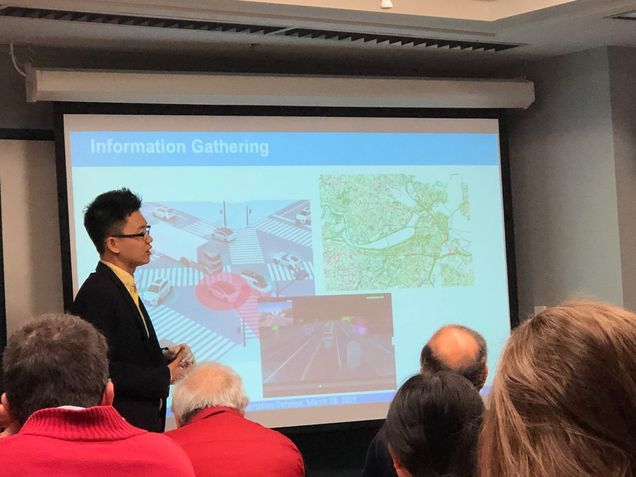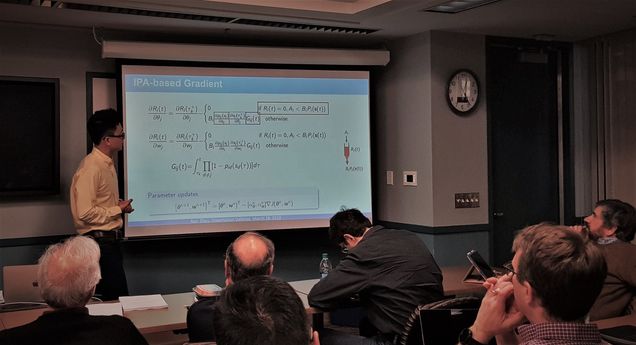Congratulations to Dr. Nan Zhou on his successful Doctoral Thesis Defense.
During his time at BU and at CODES Lab, Dr. Zhou’s research focused on robotic motion planning, control, and optimization with applications ranging from a single robotic controller to large-scale interconnected autonomous vehicles. In particular, he used Dynamic Programming to uncover parametric policies for the Persistent Monitoring problem and Infinitesimal Perturbation Analysis to learn its optimal parameter. He tackled the persistent monitoring problem considering a single and multiple agents. To learn more about him, please go to his website.
Dr Zhou’s broad interests and joyful personality has made him an important part of the BU community. Not surprisingly, his dissertation defense was full of faculty and students from the department.

Below is the abstract from his dissertation defense:
In persistent monitoring tasks, a group of cooperating mobile agents is used to monitor a dynamically changing environment that cannot be fully covered by stationary agents. The exploration process leads to the discovery of various points of interest to be perpetually monitored.
First, using optimal control, the solution can be reduced to a simpler parametric form in one-dimensional and two-dimensional mission spaces with constrained agent mobility. The behavior of agents under optimal control is described by a hybrid system which can be analyzed using Infinitesimal Perturbation Analysis (IPA) to obtain an online solution. IPA allows the modeling of virtually arbitrary stochastic effects in target uncertainty and meanwhile its event-driven nature renders the solution scalable in the number of events rather than the state space.

The second part of his work extends the previous by developing decentralized controllers which distribute functionality to the agents. Each agent then acts upon local information and sparse communication with neighbors. Conditions are identified under which the centralized solution can be exactly recovered in a decentralized event-driven manner based on local information— except for one event requiring communication from a non-neighbor agent. As we will saw during his dissertation, ignoring this non-local event only results in little loss of accuracy.
In this video, one agent is performing a persistent monitoring task in a one-dimensional mission space. The optimal trajectory is fully captured by a sequence of control switching points and corresponding dwelling times (perhaps zero).
In this other animation, the agent (blue triangle) traverses on a fully connected graph comprised of 5 targets with time-varying values. The color of a target shows the priority that it should be visited.
Green = low, Magenta = median, Red = high.
Related publications:
Journal
- X. Yu, S. B. Andersson, N. Zhou, and C. G. Cassandras, “Scheduling Multiple Agents in a Persistent Monitoring Task Using Reachability Analysis”, IEEE Transactions on Automatic Control, 2018 (under review)
- Y.W. Wang, Y.W. Wei, X.K. Liu, N. Zhou, and C. G. Cassandras, “Optimal Persistent Monitoring Using Second-Order Agents with Physical Constraints“, IEEE Transactions on Automatic Control, 2018
- N. Zhou, X. Yu, S. B. Andersson, and C. G. Cassandras, “Optimal Event-Driven Multi-Agent Persistent Monitoring of a Finite Set of Data Sources”, IEEE Transactions on Automatic Control, 2018.
Conference
- N. Zhou, C. G. Cassandras, X. Yu, and S. B. Andersson, “Optimal Threshold-Based Control Policies for Persistent Monitoring on Graphs”, American Control Conference, 2019 (to appear) arXiv
- X. Yu, S. B. Andersson, N. Zhou, and C. G. Cassandras, “Optimal visiting schedule search for persistent monitoring of a finite set of targets”, American Control Conference, 2018
- N. Zhou, C. G. Cassandras, X. Yu, and S. B. Andersson, “Decentralized Event-Driven Algorithms for Multi-Agent Persistent Monitoring Tasks,” IEEE Conference on Decision and Control, 2017
- N. Zhou, C. G. Cassandras, X. Yu, and S. B. Andersson, “Optimal Event-Driven Multi-Agent Persistent Monitoring with Graph-Limited Mobility,” IFAC World Congress, 2017
- X. Yu, S. B. Andersson, N. Zhou, and C. G. Cassandras, “Optimal dwell times for persistent monitoring of a finite set of targets,” American Control Conference, 2017
- N. Zhou, X. Yu, S. B. Andersson, and C. G. Cassandras, “Optimal event-driven multi-agent persistent monitoring of a finite set of targets,” IEEE Conference on Decision and Control, 2016